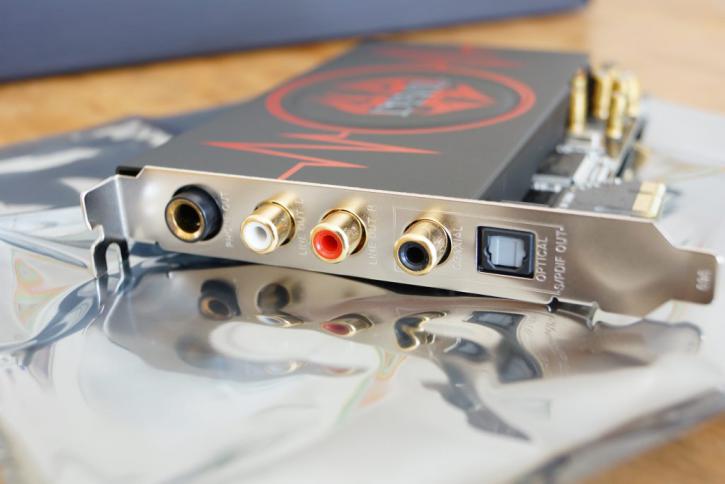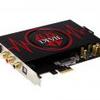Conclusion
Conclusion
The PowerColor Devil HDX is a beast of a sound card. Puns aside, you know what I mean. There are very few sound cards with the Devil’s high-end parts and high-end features. Very few sound cards have a full-sized 6.3mm headphone jack, fewer still discrete audio cards have a dedicated Wolfson DAC and amplifier to drive your precious favorite headphones. The Devil HDX even has tastefully done LED lighting.

Of course, if you must ask your Devil HDX to perform those menial tasks of driving a surround system, it will do that too. What really matters is how does it sound, how does it make you feel listening to audio through it? Glorious. It’s quite possibly the most honest sound card I’ve reviewed. There’s no sizzle in the high end, no wooly bass bloat, the Devil HDX just puts out lively, clean sound. I’m beginning to think it needs a different name than Devil HDX. Let’s call it The Spirit HDX, or if we want to keep the biblical thing going, let’s call it The Preacher.
The only downsides we found were the need for a molex power connector and Xear effects that distorted above 48KHz sample rates. The design of the Devil HDX benefits greatly by the separate power supply, shown by its very clean sound quality. The distorted Xear effects might be much more of an issue, however. Whether it’s a design flaw in the hardware or just a software issue in the Windows 10 driver is not clear, and something to keep in mind if you’re turning the effects on and off.
Games are now on the edge where photorealism is possible at playable frame rates. How about the audio? In the age when video game composers are getting well known, a sound card upgrade like the Devil HDX would be well worth the extra cost to increase immersion. Of the three games we tested extensively (read 100+ hours), the Witcher 3 benefitted the most. While the slightly bass-shy nature of the Devil HDX affected things like horse hooves hitting the ground, all the audio was exceptionally detailed and clear.

Final Words
Some astute Guru3D readers have pointed out that the Devil HDX is actually a rebranded card from AIM, the SC808. This stokes the fires somewhat, why would you want to shell out extra cash for the same card? Despite PowerColor’s rather good packaging, tech support, and unfathomable well of material for puns in the Devil name, it’s a tough choice to justify the extra premium for the Devil HDX either. You may want the support from a well established company like PowerColor, or just like the Devil brand and red LED lighting. I leave that choice up to you, dear reader, but I think I would buy the Devil HDX if it were my choice.
Recommended
Our moment of zen.

------
Aditional notes based on some of the article comments:
------
First the omission of RMAA tests is intentional. The outputs of these sound cards is getting so good that it far exceeds the ability to measure accurately with the on board ADC. I saw evidence of ADC's masking the true fidelity of the DAC portion around the SB X-Fi days. Yep, you need an Audio Precision audio analyzer to get started these days. Ain't nobody got time for that. So, based on that, I prefer to use my ears, and A/B with my reference DAC/Amp and note the differences. However, that should have been made abundantly clear in the article.
Our readers are a pretty sharp bunch, and that's a compliment. One comment about the Nichicon MUSE capacitors is on point. After looking at the pictures of the card, the Devil HDX does not use Nichicon MUSE, but Nichicon FW type audio capacitors. Now that I've been schooled, I learned. . Just for reference Nichicon MUSE start at ES (in green color), KZ (look the same as FW type, but say 'MUSE' on them), and culminate with the FG (fine gold) series.
For benchmarks, it is interesting to see about CPU usage with DVD and video playback versus onboard audio. I stopped providing numbers in games and DVD playback simply because the difference was around 2-3% (going back to the Sound Blaster X-Audio). It makes pretty graphs, but statistically nonsense. I think benchmarks, or measuring the efficiency of the drivers, was very practical back in the Windows XP days, before Microsoft killed off DirectSound3D. However, I am interested in doing some benchmarks, so I'll get those underway!
The AKG K701 headphones I used are indeed 62 Ohm, and not 32 Ohm as I had stated. My mistake, I humbly offer a correction. As far as I'm aware, the headphone output will have enough juice to drive a 600 Ohm load. I didn't test that, naturally. I'm not flush with enough cash to purchase headphones with that kind of impedance . The AKG K701 do provide a high enough impedance to weed out wimpy audio cards, however.
One commenter, has some good points, though. The basic block diagram, which I'm not really qualified to make up (I'm a techie musician, not an electrical engineer!), has some interesting qualities. Namely, it drives only two channels, either headphone out or the RCA with the Wolfson DAC. I believe I noted that in the review, including that the 5.1/7.1 outputs are driven by another CMI codec. I wanted to limit the scope of the review to just the headphone outputs, since I believe the output of the surround will be amplified by another device, and/or have room effects and so be non meaningful. That is, we can be assured that the CMI codec is much more than capable of making great sound before amplification and room acoustics muddy the sound.
His other comments about, ASIO and SPDIF passthrough. I did not test ASIO, but I can do that. SPDIF passthrough was excellent, however. I was able to run my little Audio-gd at 192KHz/24bit and it worked great. The first Win10 driver that I used would revert to headphone output upon reboot, but not with the revised driver, thankfully. I regret the omission from the review. Other than the >48KHz distortion, the Devil HDX is capable of bit-matched playback using Foobar2K (v1.38) all the way up to 192/24.
In regards to Noisiv's comment, RMAA is great for testing the electrical characteristics of the card, but as I said, the analog to digital conversion masks the true performance of the DAC. These are objective measurements. Done. RMAA doesn't do the subjective measurements, and I think we'll all agree, it's really hard to listen to a graph with your eyes. I also state that at the top of the listening tests, these are subjective listening tests. I exhaustively A/B the sound cards and duly note the differences using very familiar music against the reference. This goes on for days and weeks.
There is the problem of seeming to be selling snake oil with subjective reviews. Basically, it's all about the reference. The reference could be an iPod, a TV, a toilet paper roll, anything. The subjective review is based on the sound compared to the reference.
------
+++BAM




